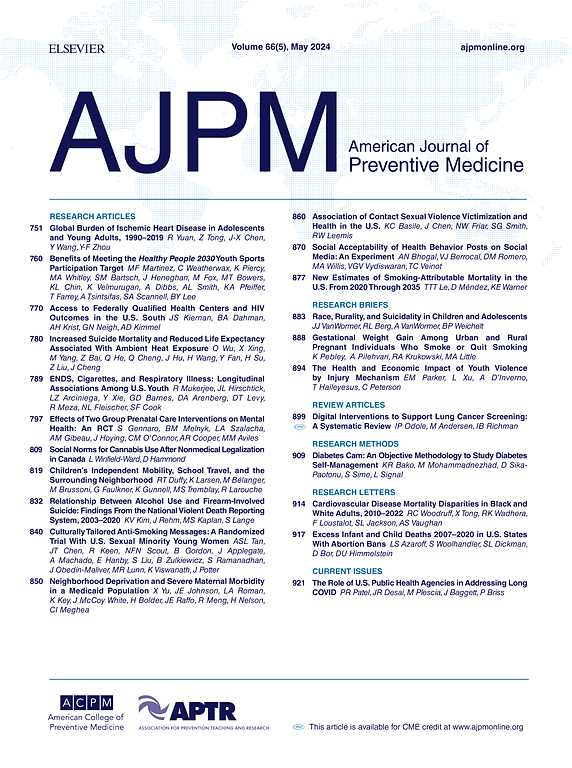部落大麻占有法:禁止在美洲原住民国家合法化。
IF 4.5
2区 医学
Q1 MEDICINE, GENERAL & INTERNAL
引用次数: 0
摘要
导读:在美国大麻政策的重大演变中,随着许多州采取更宽松的法规,在了解美国印第安人/阿拉斯加土著部落如何在部落管辖范围内管理大麻方面存在显着的差距。本研究旨在系统地记录大麻在部落法律中的法律地位。方法:使用国家印第安法律图书馆的部落法律门户数据库编制了截至2025年1月的部落财产法律档案,并辅以部落网站的互联网搜索。然后将检索到的法律文件分为四组:禁止、非刑事化、医学允许和娱乐允许。结果:分析显示,185个部落的大麻持有法律存在显著的异质性,从严格禁止和不同的惩罚到非犯罪化、医疗合法化和娱乐合法化,政策框架各不相同。虽然一些部落的政策与周围的州法律保持一致,但其他部落的政策却与州和联邦法规背道而驰。在许多部落,持有大麻仍然是非法的;16个部落将持有大麻合法化,38个部落只允许医用大麻,78个部落将娱乐用大麻合法化。结论:部落大麻占有的法律地图提供了对部落大麻管制的地形和程度的新理解。它突出了部落主权、州和联邦因素形成的复杂监管环境。观察到的差异表明,需要制定明确的联邦指导方针,尊重部落自治,并支持根据部落社区的独特需求制定适合文化的监管框架。本文章由计算机程序翻译,如有差异,请以英文原文为准。
Tribal Marijuana Possession Laws: Prohibition to Legalization Among Native American Nations
Introduction
Amid the significant evolution of marijuana policy in the U.S., with numerous states adopting more permissive regulations, a notable gap exists in understanding how American Indian/Alaska Native tribes govern marijuana within tribal jurisdictions. This study aims to systematically document the legal status of marijuana possession in tribal laws.
Methods
An archive of tribal possession laws was compiled as of January 2025 using the National Indian Law Library’s Tribal Laws Gateway database, and this was supplemented with internet searches of tribal websites. The retrieved legal documents were then classified into 4 groups: prohibited, decriminalized, medically permitted, and recreationally permitted.
Results
The analysis revealed significant heterogeneity in the marijuana possession laws of 185 tribes, ranging from strict prohibitions with varying penalties to decriminalization, medical legalization, and recreational legalization with diverse policy frameworks. Whereas some tribes had policies aligned with surrounding state laws, others maintained distinct policies that diverged from both state and federal regulations. Marijuana possession remained illegal in many tribes; 16 tribes decriminalized possession, 38 permitted only medical marijuana, and 78 legalized recreational marijuana.
Conclusions
This legal mapping of tribal approaches to marijuana possession provides a novel understanding of the topography and extent of tribal marijuana regulation. It highlights the intricate regulatory environment shaped by tribal sovereignty and state and federal factors. The observed variability shows the need for clear federal guidelines that respect tribal self-governance and support the development of culturally appropriate regulatory frameworks tailored to the unique needs of tribal communities.
求助全文
通过发布文献求助,成功后即可免费获取论文全文。
去求助
来源期刊

American Journal of Preventive Medicine
医学-公共卫生、环境卫生与职业卫生
CiteScore
8.60
自引率
1.80%
发文量
395
审稿时长
32 days
期刊介绍:
The American Journal of Preventive Medicine is the official journal of the American College of Preventive Medicine and the Association for Prevention Teaching and Research. It publishes articles in the areas of prevention research, teaching, practice and policy. Original research is published on interventions aimed at the prevention of chronic and acute disease and the promotion of individual and community health.
Of particular emphasis are papers that address the primary and secondary prevention of important clinical, behavioral and public health issues such as injury and violence, infectious disease, women''s health, smoking, sedentary behaviors and physical activity, nutrition, diabetes, obesity, and substance use disorders. Papers also address educational initiatives aimed at improving the ability of health professionals to provide effective clinical prevention and public health services. Papers on health services research pertinent to prevention and public health are also published. The journal also publishes official policy statements from the two co-sponsoring organizations, review articles, media reviews, and editorials. Finally, the journal periodically publishes supplements and special theme issues devoted to areas of current interest to the prevention community.
 求助内容:
求助内容: 应助结果提醒方式:
应助结果提醒方式:


